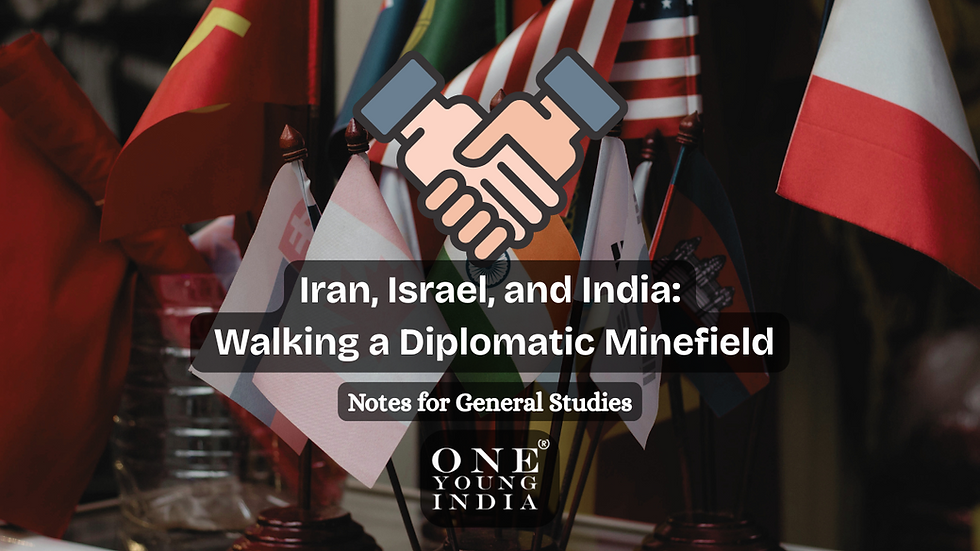Iran, Israel, and India: Walking a Diplomatic Minefield
- One Young India

- Aug 8, 2025
- 4 min read
India's foreign policy has long been defined by a fine balancing act. Nowhere is this more evident than in its simultaneous diplomatic relationships with Iran and Israel. Both nations are geopolitically significant, economically important, and ideologically at odds. Iran, a predominantly Shia Islamic republic, has historically opposed Israel's existence as a state. Israel, a Western-aligned democracy in the Middle East, views Iran as its primary regional threat. Despite this deep hostility between Iran and Israel, India has cultivated strong ties with both.

In this blog, we explore how India manages this diplomatic tightrope and what it means for its strategic future.
1. Historical Background: India and the Middle East
India's connection with the Middle East dates back centuries. From the spice routes to Mughal-Persian exchanges, ties with Iran and the broader Islamic world were long-standing before the emergence of modern diplomatic states.
After independence in 1947, India adopted a policy of non-alignment during the Cold War. This allowed it to build relationships with diverse partners, including Arab nations and Iran, without alienating others. Meanwhile, India did not have formal diplomatic relations with Israel until 1992, largely due to its support for the Palestinian cause and fear of alienating Muslim-majority countries.
2. India-Iran Relations: Shared History and Strategic Depth
2.1 Cultural and Economic Ties
Iran and India share civilizational roots—from language (Persian was once the court language in India) to art and architecture. Economically, Iran has been a key energy supplier to India. For decades, India has relied on Iranian oil to meet its growing energy demands.
2.2 Strategic Importance
One of the cornerstones of the India-Iran relationship is the Chabahar Port. Located on the Gulf of Oman, this port gives India direct access to Afghanistan and Central Asia, bypassing Pakistan. It is also part of India’s broader strategy to counter China’s Belt and Road Initiative.
2.3 Sanctions and Setbacks
U.S.-imposed sanctions on Iran, especially after Washington exited the Iran nuclear deal in 2018, forced India to reduce oil imports and scale down its involvement in Chabahar. This has strained ties but not broken them.
3. India-Israel Relations: From Hesitation to Strategic Embrace
3.1 Diplomatic Normalization
India established full diplomatic relations with Israel in 1992, but relations had existed discreetly even before that, particularly in defense and intelligence cooperation.
3.2 Defense and Technology
Israel is one of India’s top defense suppliers. From drones and radar systems to anti-missile technology and cyber security tools, the cooperation is robust and growing. Indian armed forces rely heavily on Israeli military tech.
3.3 Agricultural and Scientific Innovation
Israel's cutting-edge agricultural and water management technologies have been a boon to Indian farmers. The two countries have launched multiple Indo-Israel Centers of Excellence across Indian states to promote high-yield crops and water conservation.
4. The Tightrope Act: Balancing Iran and Israel
4.1 Avoiding Public Alignment
India has largely refrained from publicly taking sides in the Iran-Israel rivalry. It has maintained a careful tone in international forums and avoided voting against either country in the UN.
4.2 Pragmatism Over Ideology
New Delhi’s diplomacy is increasingly shaped by pragmatic interests rather than ideological alignment. While Israel provides advanced technology and defense systems, Iran offers geographic and strategic depth in Central Asia.
4.3 Economic Considerations
India’s growing economy demands energy security and technological advancement. This necessitates cordial relations with Iran for oil and port access, and with Israel for defense and innovation.
5. External Pressures and Challenges
5.1 The U.S. Factor
India's ties with both Iran and Israel are complicated by its strong relationship with the United States. Washington’s hardline stance on Iran, including secondary sanctions, limits India’s ability to deepen engagement with Tehran. On the other hand, the U.S.-Israel relationship complements India’s own defense and strategic ties with Tel Aviv.
5.2 The China Angle
Iran has grown closer to China, especially after signing a 25-year cooperation agreement. India must navigate this dynamic, especially as tensions with China remain high. Similarly, Israel’s increasing technological exports to China have raised concerns in Washington, affecting global tech geopolitics.
5.3 Regional Volatility
Instability in the Middle East poses inherent risks. An Iran-Israel conflict could disrupt energy supplies, impact the safety of Indian nationals in the region, and challenge India’s diplomatic neutrality.
6. India’s Strategic Dilemma
India faces three main dilemmas:
Security vs. Sovereignty: Engaging with Israel offers immediate defense upgrades, but distancing from Iran affects India’s influence in West and Central Asia.
U.S. Relations vs. Independent Policy: Navigating American expectations while pursuing an autonomous foreign policy is increasingly difficult.
Economic Necessity vs. Political Neutrality: India's energy and trade interests demand balance, but geopolitical currents often push in opposite directions.
7. The Way Forward
7.1 Diversification and Multilateralism
India can cushion the volatility of bilateral ties through regional and global multilateral forums like the Shanghai Cooperation Organization (SCO) and BRICS. Engagement with the Gulf Cooperation Council (GCC) and ASEAN also offers broader diplomatic leverage.
7.2 Strategic Silence and Quiet Diplomacy
India’s strength has been its ability to maintain cordial relations through strategic ambiguity. This should be continued—public statements should remain neutral, while diplomatic ties deepen behind closed doors.
7.3 Energy Alternatives
To reduce overdependence on any one country, India must invest in energy diversification—including renewables, nuclear partnerships, and import diversification.
7.4 Technology and Cultural Diplomacy
While military and energy interests are core, people-to-people ties, educational exchanges, and cultural diplomacy can build long-term goodwill and resilience in diplomatic relationships.
Conclusion
India’s diplomacy with Iran and Israel is a masterclass in realpolitik. As global tensions rise and alliances shift, India must continue walking this diplomatic minefield with calculated steps. The stakes are high—energy security, regional stability, technological advancement, and global reputation.
In a world of increasingly binary choices, India’s ability to maintain a multivector foreign policy could be its greatest strategic asset. Balancing Iran and Israel isn’t just about survival; it’s about asserting India’s role as a global power in a polarized world.



